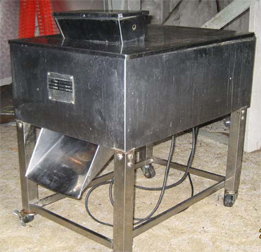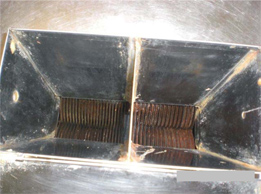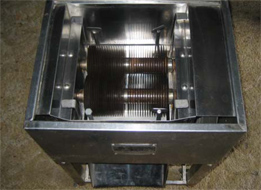Meat processing machines
Use of unsafe meat processing machines can result in serious injury.
There are a number of imported meat slicing machines used to slice, mince, grind and or tenderise meat and meat products. These machines are often found in takeaway outlets and restaurants and used by butchers and caterers.

What are the hazards?
The main hazards are:
- The rotating cutting blades can be accessed through the feed hopper and the dispenser chute. Contact with the moving blades can cause severe injuries.

- The cutting blades are susceptible to rusting and food residue can build up on surfaces that are difficult to access to clean and sanitise. This may lead to food health issues when food comes into contact with surfaces that have not been effectively cleaned.
- The feed hopper and top cover are regularly removed for cleaning purposes and this further exposes the blades. Some brands of these machines may continue to operate with the hopper or cover removed, increasing the risk of serious injury.

- If the unit has not been manufactured and maintained in accordance with relevant electrical standards the conductive metal body poses a greater risk of electric shock. This risk is heightened when water is used to clean the machine while it is connected to the power socket.
- There is no emergency stop device to quickly stop the machine in an emergency.
These are just a few hazards. There may be more!
Tips to reduce the risks
Importers, designers, suppliers, installers and persons conducting a business or undertaking each have an obligation to ensure that meat processing machinery is safe and without risk to health and safety when used properly. Follow these simple steps to reduce the risks:
- Conduct a risk assessment at various stages throughout the life of a meat processing machine – from when it is new, relocated or following an incident.
- Check the machine does not have exposed moving parts by using
- appropriate fixed guarding that require tools for removal (e.g. distance guards on a feed chute), or
- interlocked moveable guards that cannot be opened until the machine comes to a stop (the control system should not allow the machine to start while the guards are removed).
- Check that that machine has emergency stop device/s.
- Check that the emergency stop device/s are located in areas that are easily accessible to the machine operator/s.
- Check all supply cords and plugs before each use for signs of wear and tear (e.g. check from plug pins to cord entry for cuts and abrasions) and whether the cord anchorage is effective.
- Ensure that the safety-related parts of the control systems such as interlocks and emergency stops comply with the relevant technical standards.
- Ensure the design and construction of the machine ensures safe access for maintenance and effective cleaning and sanitisation.
- Ensure any electrical devices (e.g. switches) on the machine are of a suitable type for protection from elements like splashing water.
- Ensure the machine complies with the relevant electrical safety legislation.
- Ensure information is readily available about the way the machine must be used to ensure health and safety.
These tips are a guide only. Each machine is different and has its own hazards and risks. Consult an engineer, machinery safety specialist or the manufacturer of the meat processing machine to find more about how to reduce the risks associated with operating each machine.